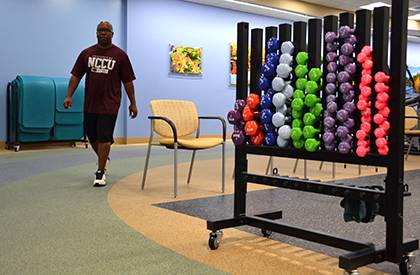Save a Life: Learn CPR
The Duke Heart Center is offering free CPR training to Duke employees on June 12

A blocked artery in Nathan Russell’s heart struck in March as he was traveling back from a softball game at Elon University, where he was coaching the N.C. Central University team. Russell passed out in the team van, just blocks from Duke Hospital, where the van driver stopped to get help. A Duke Medicine team gave Russell CPR, used an automated external defibrillator (AED) to administer a shock and drilled a hole in his leg to administer epinephrine. Doctors later told Russell he coded three times and was dead for five minutes. “You never know walking down the street, walking in the park, taking the kids out, anything could happen to anybody,” said Russell, a team lead for Duke Health Technology Solutions and a N.C. Central University assistant softball coach. “If you really have that knowledge of CPR and that experience, you could really make a difference and save a life.”The Duke Heart Center is providing free CPR training on June 12 to Duke employees in recognition of National CPR Awareness Month in June. Registration is open for hour-long time slots from 10 a.m. to 3 p.m. The class involves compression-only CPR, which is CPR without mouth-to-mouth resuscitation. Immediate CPR can double to triple a sudden cardiac arrest victim’s chance of survival, according to the American Heart Association. Compression-only CPR, a simpler technique, may help community responders overcome panic and hesitation to act. “We believe it’s critically important to have all Duke employees trained on how to do CPR,” said Dr. Chris Granger, director of Duke’s Cardiac Care Unit. “Don’t think about CPR as something that’s going to be uncomfortable and a challenge. Think of it as one of the greatest opportunities to help save someone’s life.”During training, participants will form teams and respond to different hypothetical situations on and off campus. They will learn steps of using compression-only CPR, dialing 911, and deploying an AED. Instructors will also discuss how to use the Heimlich maneuver to help someone who’s choking.The Duke Heart Center, which began offering free training to large Duke groups in 2011, is partnering with groups outside of Duke, most recently with companies in Research Triangle Park to teach their employees CPR.“Our program is a model for other companies to train their employee base,” said Leatrice Martin, director of the Duke Heart Center Community Outreach and Education Program. Russell, the cardiac arrest survivor, has his own CPR certification, which he renews every year as a university softball coach. Three months after his collapse in the van, he’s running on the treadmill at the Duke Cardiopulmonary Rehabilitation clinic three mornings a week and incorporating lean meats, fruits and vegetables into his diet. At 44 years old, he has diabetes and high cholesterol, but no history of heart disease in his family. “I am a walking miracle,” Russell said. “It’s miraculous the way that I recovered.”